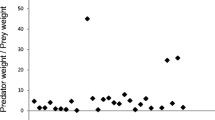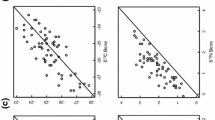Abstract
The morphological, physiological, and behavioural traits of organisms are often used as surrogates for actual ecological functions. However, differences in these traits do not necessarily lead to functional differences and/or can be context–dependent. Therefore, it is necessary to explicitly test whether the surrogates have general ecological relevance. To investigate the relationship between the hunting strategies of predators (i.e., how, where, and when they hunt) and their function, we used euryphagous spiders as a model group. We used published data on the diet composition of 76 spider species based on natural prey and laboratory prey acceptance experiments. We computed differences in the position and width of trophic niches among pairs of sympatrically occurring species. Pairs were made at different classification levels, ranked according to the dissimilarity in their hunting strategies: congeners, confamiliars (as phylogenetic proxies for similarity in hunting strategy), species from the same main class of hunting strategy, from the same supra-class, and from different supra-classes. As for niche position computed from the natural prey analyses, species from the same class differed less than species from different classes. A similar pattern was obtained from the laboratory studies, but the congeners differed less than the species from the same classes. Niche widths were most similar among congeners and dissimilar among species from different supra-classes. Functional differences among euryphagous spiders increased continuously with increasing difference in their hunting strategy. The relative frequency of hunting strategies within spider assemblages can, therefore, influence the food webs through hunting strategy-specific predator–prey interactions.



Similar content being viewed by others
References
Almeida Jácomo AT, Silveira L, Diniz-Filho JAF (2004) Niche separation between the manned wolf (Chrysocyon brachyurus), the crab-eating fox (Dusicyon thous) and the hoary fox (Dusicyon vetulus) in central Brazil. J Zool 262:99–106. doi:10.1017/S0952836903004473
Araújo MS, Bolnick DI, Layman CA (2011) The ecological causes of individual specialisation. Ecol Lett 14:948–958. doi:10.1111/j.1461-0248.2011.01662.x
Birkhofer K, Entling MH, Lubin Y (2013) Agroecology: trait composition, spatial relationships, trophic interactions. In: Penney D (ed) Spider research in the 21st Century: trends and perspectives. SIRI Scientific Press, Castleton, pp 220–228
Bolnick DI, Amarasekare P, Araújo MS, Bürger R, Levine MJ, Novak M, Rudolf VHW, Schreiber SJ, Urban MC, Vasseur DA (2011) Why intraspecific trait variation matters in community ecology. Trends Ecol Evol 26:183–192. doi:10.1016/j.tree.2011.01.009
Butt A, Tahir HM (2010) Resource partitioning among five agrobiont spiders of a rice ecosystem. Zool Stud 49:470–480
Calandra I, Göhlich UB, Merceron G (2008) How could sympatric megaherbivores coexist? Example of niche partitioning within a proboscidean community from the Miocene of Europe. Naturwissenschaften 95:831–838. doi:10.1007/s00114-008-0391-y
Cardoso P, Pekár S, Jocqué R, Coddington JA (2011) Global patterns of guild composition and functional diversity of spiders. PLoS One 6:e21710. doi:10.1371/journal.pone.0021710
Carter PE, Rypstra AL (1995) Top-down effects in soybean agroecosystems: spider density affects herbivore damage. Oikos 72:433–439. doi:10.2307/3546129
Cerveira A, Jackson RR (2002) Prey, predatory behaviour, and anti-predator defences of Hygropoda dolomedes and Dendrolycosa sp. (Araneae: Pisauridae), web-building pisaurid spiders from Australia and Sri Lanka. New Zeal J Zool 29:119–133. doi:10.1080/03014223.2002.9518295
Chalcraft DR, Resetarits WJ Jr (2003a) Mapping functional similarity of predators on the basis of trait similarities. Am Nat 162:390–402. doi:10.1086/378210
Chalcraft DR, Resetarits WJ Jr (2003b) Predator identity and ecological impacts: functional redundancy or functional diversity? Ecology 84:2407–2418. doi:10.1890/02-0550
Chase JM, Leibold MA (2003) Ecological niches: linking classical and contemporary approaches. Univ Chicago Press, Chicago
Colwell RK (2013) EstimateS: Statistical estimation of species richness and shared species from samples. Version 9. User’s Guide and application. http://purl.oclc.org/estimates. Accessed 16 Sept 2014
Davies JT, Meiri S, Barraclough TG, Gittleman JL (2007) Species co-existence and character divergence across carnivores. Ecol Lett 10:146–152. doi:10.1111/j.1461-0248.2006.01005.x
Elliott JP, Bellwood DR (2003) Alimentary tract morphology and diet in three coral reef fish families. J Fish Biol 63:1598–1609. doi:10.1111/j.1095-8649.2003.00272.x
Folz HC, Wilder SM, Persons H, Rypstra AL (2006) Effects of predation risk on vertical habitat use and foraging of Pardosa milvina. Ethology 112:1152–1158. doi:10.1111/j.1439-0310.2006.01276.x
Geange SW, Pledger S, Burns KC, Shima JS (2011) A unified analysis of niche overlap incorporating data of different types. Method Ecol Evol 2:175–184. doi:10.1111/j.2041-210X.2010.00070.x
Gotelli NJ, Colwell RK (2001) Quantifying biodiversity: procedures and pit-falls in the measurement and comparison of species richness. Ecol Lett 4:379–391. doi:10.1046/j.1461-0248.2001.00230.x
Gotelli NJ, Graves GR (1996) Null models in ecology. Smithsonian Inst Press, Washington, DC
Greene HW, Jaksić FM (1983) Food-niche relationships among sympatric predators: effects of level of prey identification. Oikos 40:151–154. doi:10.2307/3544212
Greiner B, Narendra A, Reid SF, Dacke M, Ribi WA, Zeil J (2007) Eye structure correlates with distinct foraging-bout timing in primitive ants. Curr Biol 17:879–880. doi:10.1016/j.cub.2007.08.015
Griffen BD, Byers JE (2006) Intraguild predation reduces redundancy of predator species in multiple predator assemblage. J Anim Ecol 75:959–966. doi:10.1111/j.1365-2656.2006.01115.x
Gutman R, Dayan T (2005) Temporal partitioning: an experiment with two species of spiny mice. Ecology 86:164–173. doi:10.1890/03-0369
Hayward MW, Kerley GI (2008) Prey preferences and dietary overlap amongst Africa’s large predators. S Afr J Wildl Res 38:93–108
Herberstein ME (1998) Web placement in sympatric linyphiid spiders (Arachnida, Araneae): individual foraging decisions reveal inter-specific competition. Acta Oecol 19:67–71. doi:10.1016/S1146-609X(98)80009-X
Herberstein ME (2011) Spider behaviour: flexibility and versatility. Cambridge University Press, Cambridge
Herberstein ME, Elgar MA (1994) Foraging strategies of Eriophora transmarine and Nephila plumipes (Araneae: Araneoidea): Nocturnal and diurnal orb-weaving spiders. Aust Ecol 19:451–457. doi:10.1111/j.1442-9993.1994.tb00511.x
Husar SL (1976) Behavioral character displacement: evidence of food partitioning in insectivorous bats. J Mammal 57:331–338. doi:10.2307/1379692
Ingram T, Svanbäck R, Kraft NJ, Kratina P, Southcott L, Schluter D (2012) Intraguild predation drives evolutionary niche shift in three spine stickleback. Evolution 66:1819–1832. doi:10.1111/j.1558-5646.2011.01545.x
Jennings DE, Krupa JJ, Raffel TR, Rohr JR (2010) Evidence for competition between carnivorous plants and spiders. Proc R Soc B Biol Sci 277:3001–3008. doi:10.1098/rspb.2010.0465
Kneitel JM, Chase JM (2004) Trade-offs in community ecology: linking spatial scales and species coexistence. Ecol Lett 7:69–80. doi:10.1046/j.1461-0248.2003.00551.x
Kramer DL, Bryant MJ (1995) Intestine length in the fishes of a tropical stream: 1. Ontogenetic allometry. Environ Biol Fish 42:115–127. doi:10.1007/BF00001990
Lande R (1996) Statistics and partitioning of species diversity, and similarity among multiple communities. Oikos 76:5–13. doi:10.2307/3545743
Lepš J, de Bello F, Lavorel S, Berman S (2006) Quantifying and interpreting functional diversity of natural communities: practical considerations matter. Preslia 78:481–501
Liu S, Chen J, Gan W, Schaefer D, Gan J, Yang X (2015a) Spider foraging strategy affects trophic cascades under natural and drought conditions. Sci Rep 5:12396. doi:10.1038/srep12396
Liu S, Li Z, Sui Y, Schaefer DA, Alele PO, Chen J, Yang X (2015b) Spider foraging strategies dominate pest suppression in organic tea plantations. Biocontrol 60:839–847. doi:10.1007/s10526-015-9691-2
Líznarová E, Sentenská L, García LF, Pekár S, Viera C (2013) Local trophic specialisation in a cosmopolitan spider (Araneae). Zoology 116:20–26. doi:10.1016/j.zool.2012.06.002
Lovari S, Pokheral CP, Jnawali SR, Fusani L, Ferretti F (2015) Coexistence of the tiger and the common leopard in a prey-rich area: the role of prey partitioning. J Zool 295:122–131. doi:10.1111/jzo.12192
Lubin YD, Eberhart WG, Montgomery GG (1978) Webs of Miagrammopes (Araneae: Uloboridae) in the neotropics. Psyche 85:1–23. doi:10.1155/1978/72579
Ludy C (2007) Prey selection of orb-web spiders (Araneidae) on field margins. Agric Ecosyst Environ 119:368–372. doi:10.1016/j.agee.2006.08.005
Michalko R, Pekár S (2014) Is different degree of individual specialization in three spider species caused by distinct selection pressures? Basic Appl Ecol 15:496–506. doi:10.1016/j.baae.2014.08.003
Michalko R, Pekár S (2015a) Niche partitioning and niche filtering jointly mediate the coexistence of three closely related spider species (Araneae, Philodromidae). Ecol Entomol 40:22–33. doi:10.1111/een.12149
Michalko R, Pekár S (2015b) The biocontrol potential of Philodromus (Araneae, Philodromidae) spiders for the suppression of pome fruit orchard pests. Biol Control 82:13–20. doi:10.1016/j.biocontrol.2014.12.001
Miller JRB, Ament JM, Schmitz OJ (2014) Fear on the move: predator hunting mode predicts variation in prey mortality and plasticity in prey spatial response. J Anim Ecol 83:214–222. doi:10.1111/1365-2656.12111
Mlambo MC (2014) Not all traits are ‘functional’: insights from taxonomy and biodiversity-ecosystem functioning research. Biodivers Conserv 23:781–790. doi:10.1007/s10531-014-0618-5
Nyffeler M (1999) Prey selection of spiders in the field. J Arachnol 27:317–324
Nyffeler M, Sterling WL (1994) Comparison of the feeding niche of polyphagous insectivores (Araneae) in a Texas cotton plantation: estimates of niche breadth and overlap. Environ Entomol 23:1294–1303. doi:10.1093/ee/23.5.1294
Odden M, Wegge P, Fredriksen T (2010) Do tigers displace leopards? If so, why? Ecol Res 25:875–881. doi:10.1007/s11284-010-0723-1
Palkovacs EP, Post DM (2009) Experimental evidence that phenotypic divergence in predators drives community divergence in prey. Ecology 90:300–305. doi:10.1890/08-1673.1
Pekár S, Brabec M (2009) Modern analysis of biological data. 1. Generalized linear models in R. Scientia, Czech
Pekár S, Brabec M (2012) Modern analysis of biological data. 2. Linear models with correlation in R. Muni Press, Czech
Pekár S, Coddington JA, Blackledge TA (2012) Evolution of stenophagy in spiders (Araneae): evidence based on the comparative analysis of spider diets. Evolution 66:776–806. doi:10.1111/j.1558-5646.2011.01471.x
Pekár S, Šedo O, Líznarová E, Korenko S, Zdráhal Z (2014) David and Goliath: potent venom of an ant-eating spider (Araneae) enables capture of a giant prey. Naturwissenschaften 101:533–540. doi:10.1007/s00114-014-1189-8
Petchey OL, Gaston KJ (2006) Functional diversity: back to basics and looking forward. Ecol Lett 9:741–758. doi:10.1111/j.1461-0248.2006.00924.x
R Core Team (2014) R: a language and environment for statistical computing. R Foundation for Statistical Computing, Vienna, Austria. http://www.R-project.org. Accessed 25 Sept 2014
Richardson ML, Hanks LM (2009) Partitioning of niches among four species of orb-weaving spiders in a grassland habitat. Environ Entomol 38:651–656. doi:10.1603/022.038.0316
Roberts MJ (1998) Spiders of Britain and Northern Europe. Harper Collins Publications, London
Root RB (1967) The niche exploitation pattern of the blue-grey gnatcatcher. Ecol Monogr 37:317–350. doi:10.2307/1942327
Sanders D, Vogel E, Knop E (2015) Individual and species-specific traits explain niche size and functional role in spiders as generalist predators. J Anim Ecol 84:134–142. doi:10.1111/1365-2656.12271
Sargeant BL (2007) Individual foraging specialization: niche width versus niche overlap. Oikos 116:1431–1437. doi:10.1111/j.0030-1299.2007.15833.x
Schmidt JM, Rypstra AL (2010) Opportunistic predator prefers habitat complexity that exposes prey while reducing cannibalism and intraguild encounters. Oecologia 164:899–910. doi:10.1007/s00442-010-1785-z
Schmitz OJ (2005) Behavior of predators and prey and links with population-level processes. In: Barbosa P, Castellanos I (eds) Ecology of predator-prey interactions. Oxford University Press, Oxford
Schmitz OJ (2008) Effects of predator hunting mode on grassland ecosystem function. Science 319:952–954. doi:10.1126/science.1152355
Šmilauer P, Lepš J (2014) Multivariate analysis of ecological data using Canoco 5. Cambridge University Press, New York
Smith EP (1982) Niche breadth, resource availability, and inference. Ecology 63:1675–1681. doi:10.2307/1940109
Spiller DA (1984) Competition between two spider species: experimental field study. Ecology 65:909–919. doi:10.2307/1938064
Straub CS, Ives AR, Gratton C (2011) Evidence for a trade-off between host-range breadth and host-use efficiency in aphid parasitoids. Am Nat 177:389–395. doi:10.1086/658177
Ter Braak CJF, Šmilauer P (2012) Canoco 5. Software for multivariate data exploration, testing, and summarization. Microcomputer Power, Ithaca, USA
Toft S (1999) Prey choice and spider fitness. J Arachnol 27:301–307
Uetz GW (1977) Coexistence in a guild of wandering spiders. J Anim Ecol 46:531–541. doi:10.2307/3828
Wilson DS, Yoshimura J (1994) On the coexistence of specialists and generalists. Am Nat 144:692–707
Wise DH (1993) Spiders in ecological webs. Cambridge University Press, Cambridge
Young RL, Haselkorn TS, Badyaev AV (2007) Functional equivalence of morphologies enables morphological and ecological diversity. Evolution 61:2480–2492. doi:10.1111/j.1558-5646.2007.00210.x
Young RL, Sweeney MJ, Badyaev AV (2010) Morphological diversity and ecological similarity: versatility of muscular and skeletal morphologies enables ecological convergence in shrews. Funct Ecol 24:556–565. doi:10.1111/j.1365-2435.2009.01664.x
Acknowledgments
This study was supported by the Student Project Grant no. MUNI/A/1484/2014 provided by the Masaryk University. We are very grateful to all our reviewers and to handling editor Sven Bacher for comments that significantly improved the manuscript.
Author contribution statement
RM conceived and designed the study. RM performed the data survey. RM analyzed the data. RM and SP wrote the manuscript.
Author information
Authors and Affiliations
Corresponding author
Ethics declarations
Conflict of interest
The authors declare no conflicts of interest.
Ethical approval
This article does not contain any studies with human participants or animals performed by any of the authors.
Additional information
Communicated by Sven Bacher.
Electronic supplementary material
Below is the link to the electronic supplementary material.
Rights and permissions
About this article
Cite this article
Michalko, R., Pekár, S. Different hunting strategies of generalist predators result in functional differences. Oecologia 181, 1187–1197 (2016). https://doi.org/10.1007/s00442-016-3631-4
Received:
Accepted:
Published:
Issue Date:
DOI: https://doi.org/10.1007/s00442-016-3631-4




